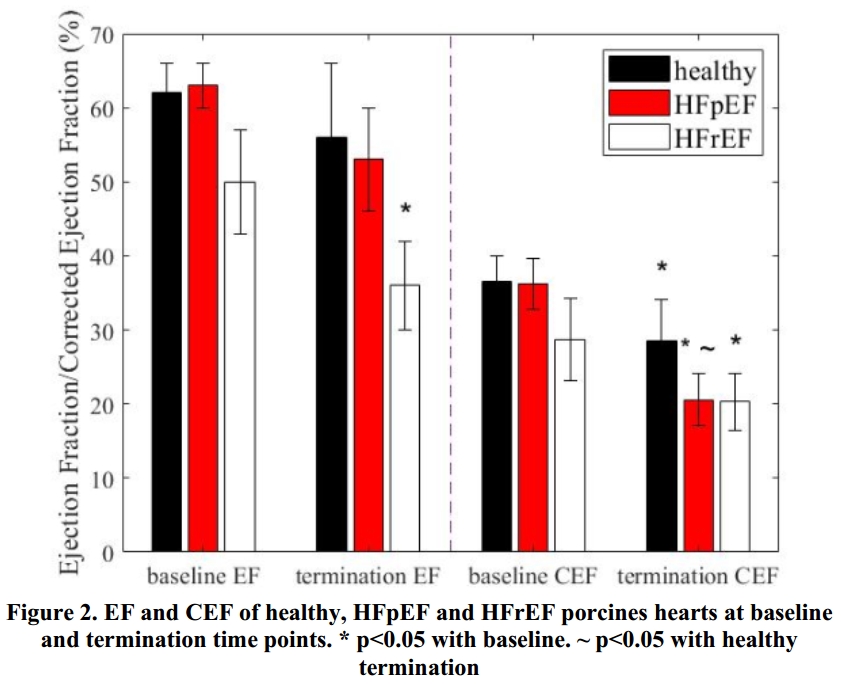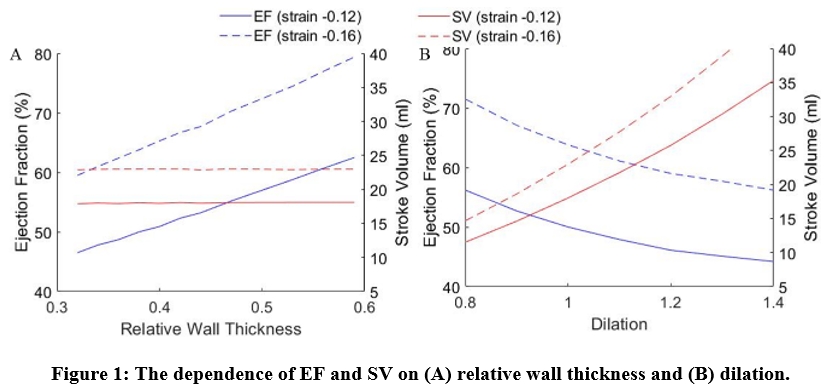Introduction Heart failure with preserved ejection fraction (HFpEF, EF ≥ 50%) and heart failure with reduced ejection fraction (HFrEF, EF ≤ 40%) are two main types of heart failure (HF) with similar prevalence. 88% of HFpEF [1] and 80% of HFrEF [2] undergo cardiac remodeling. Here we develop a myocardial numerical model to investigate how these geometric changes benefit or impede heart function. We further show that geometric changes can skew the EF measure, making it ineffective in the diagnosis of HFpEF, and propose a new corrected EF measure to improve it. Methods CMRI of 5 HFpEF porcine models (aortic banding), 10 HFrEF porcine models (circumflex ligation), and 6 sham/healthy are obtained before intervention (baseline) and at the 28th- or 42nd-day time point (termination). Cardiac anatomic and strains are measured. A numerical model of the LV is reconstructed as a discretized, idealized prolate shape, based on measured dimensions. It can undergo specific magnitudes of spatially uniform and incompressible strains, and allow the calculation of the consequent stroke volume and EF function. Results HFpEF and sham groups have EF above 50%, while HFrEF group has EF less than 40%. HFpEF experiences a concentric hypertrophy (higher LVM and wall thickness), while HFrEF experiences eccentric hypertrophy with dilation (decreased SI and unchanged RWT). Both HF models have decreased strains. With the numerical LV model, increasing wall thickness with the same strain (Fig. 1A) was found to increase EF but not SV, suggesting that higher wall thickness artificially increased EF when there is no change to flow function. Increasing dilation at the same strain (Fig. 1B) was found to increase SV but decrease EF, suggesting that dilation enhances the conversion of strain into flow function, but EF is not a successful indicator of this. Interestingly, wall thickening is found to increase the epi-to-endo spatial variability, while dilation reduces the difference. Due to radial strain, the epi- and endo- surfaces have different strains from the mid-wall layer. The epi- and endo- surfaces are thus not good locations for quantifying strain or volumetric flow function. We thus propose a novel marker, the corrected ejection fraction (CEF), which is calculated using the mid-wall layer rather than the endocardial layer: CEF = SV/VolED,mid = α×EF (1) α=VolED,endo/(VolED,endo + LVM/2ρLV) (2) When applied to the porcine data, CEF can successfully differentiate between healthy and HFpEF hearts, while EF cannot (Fig. 2), and is shown to be free of biases due to geometric changes to the heart. Conclusions From our modeling, we find that dilation to be advantageous to cardiac flow function, but not wall thickening. We further find that EF is an imperfect indication of function because it can be modulated by the cardiac geometry changes and cannot distinguish some HF phenotypes from normal because of a flawed reliance on measurements based on the endocardial boundary rather than the mid-wall layer. We proposed a corrected EF measure, the CEF, which we show can remove this geometric dependency and enable a better representation of the cardiac contractile function.
Physiology 2021 (2021) Proc Physiol Soc 48, OC61
Oral Communications: Effects Of Cardiac Geometric Remodeling During Heart Failure On Cardiac Function
Yu Zheng1, Wei Xuan Chan1, Christopher J. Charles2, 3, 4, A. Mark Richards3, 4, Smita Sampath5, Asad Abu Bakar Ali5, Choon Hwai Yap6
1 Department of Biomedical Engineering, National University of Singapore, Singapore, Singapore, Singapore 2 Department of Surgery, Yong Loo Lin School of Medicine, National University of Singapore, Singapore, Singapore, Singapore 3 Cardiovascular Research Institute, National University of Singapore, Singapore, Singapore, Singapore 4 Christchurch Heart Institute, Department of Medicine, University of Otago, Christchurch, New Zealand, Christchurch, New Zealand 5 Translational Biomarkers, Merk Sharp & Dohme, Singapore, Singapore, Singapore 6 Department of Bioengineering, Imperial College London, UK, London, United Kingdom
View other abstracts by:
Where applicable, experiments conform with Society ethical requirements.


